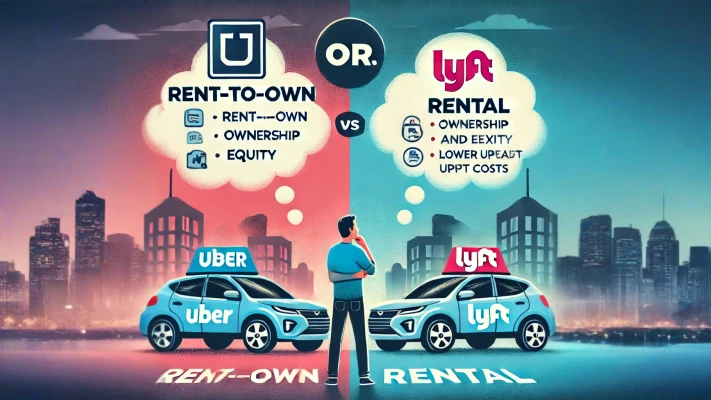
If you're considering becoming a rideshare driver for companies like Uber and Lyft, one of the most significant decisions you'll face is whether to opt for a rent-to-own arrangement or a traditional rental for your vehicle. Both options come with their own set of advantages and considerations, and making the right choice can significantly impact your financial stability and long-term goals.
Rent to Own
Rent to own, as the name suggests, offers drivers the opportunity to eventually own the vehicle they use for ridesharing. In this arrangement, drivers typically make regular payments over a specified period, with the option to purchase the vehicle outright at the end of the term. This option appeals to
those who aspire to own their vehicle but may not have the financial means or credit history to secure a traditional auto loan.
Rental
On the other hand, traditional rentals provide drivers with immediate access to a vehicle without the commitment of ownership. With rental arrangements, drivers pay a weekly or monthly fee to use the vehicle, with no obligation to purchase it at the end of the rental period. While rentals offer flexibility and convenience, they may not be the most cost-effective option in the long run for drivers seeking vehicle ownership.
Comparing the Costs
- Rent to Own: Rent-to-own agreements often involve higher upfront costs compared to traditional rentals, as drivers may be required to pay a deposit or down payment towards eventual vehicle ownership. However, over time, the payments made towards the rental accumulate equity, eventually leading to ownership of the vehicle.
- Rental: Traditional rentals offer immediate access to a vehicle with minimal upfront costs, making them an attractive option for drivers who need a vehicle quickly or prefer not to commit to ownership. However, the ongoing rental payments can add up over time, potentially exceeding the cost of ownership in the long term.
Factors to Consider When Choosing
- Financial Situation: Consider your current financial situation and long-term goals. If you have the means to afford higher upfront costs and are committed to vehicle ownership, rent-to-own may be the better option. However, if you prefer lower initial expenses and value flexibility, a traditional rental arrangement might suit you better.
- Credit History: Your credit history can also impact your ability to secure financing for a vehicle. Rent-to-own agreements may be more accessible to those with less-than-perfect credit, as they often require lower credit scores compared to traditional auto loans. If you have excellent credit, you may have more options available to you, including favorable financing rates for vehicle purchases.
- Driving Needs: Consider your driving needs and usage patterns. If you plan to drive full-time or expect to put a high mileage on the vehicle, owning may be more cost-effective in the long run. However, if you only plan to drive part-time or intermittently, renting may provide the flexibility you need without the commitment of ownership.
The decision between rent to own and traditional rental for driving with Uber and Lyft ultimately depends on your circumstances and priorities. By carefully weighing the pros and cons of each option and considering factors such as your financial situation, credit history, driving needs, and vehicle preferences, you can make an informed decision that sets you up for success in your rideshare career.
